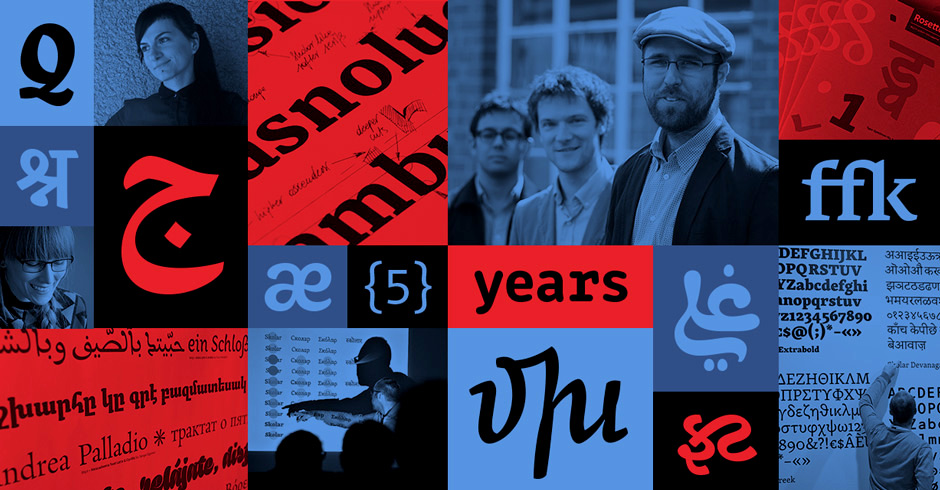It is five years today since we started Rosetta and I would like to take the opportunity to thank all our supporters, the moral ones who encouraged us with their kind words and of course our loyal customers who have been buying every font we release. We do not take that for granted!
In these five years, we have been working with over 16 designers to produce their fonts for over ten different world scripts. Broken down by scripts, we released an impressive number of 21 type families for retail and there is more to come. Add some exciting custom work we have done, but cannot talk about, and two open-source projects which you can see on GitHub. That is not too bad at all.
But it was never about churning out fonts. Although we refer to Rosetta as a publisher, we think of it as a platform. The notion is tied with a sense of design community and expanding knowledge. Our designers get extensive support in sometimes endless, and almost always painful, iterations that lead to a release of their typeface. And that typeface remains their property! The fonts are almost exclusively produced in-house and there are easier things than engineering complex Asian scripts. This way, slowly and carefully, an expertise has been developed, both ours and that of the associated designers. Thanks to that we can manage major custom projects together, and teach others. It is these largely unseen operations and explorations, expanding our knowledge base, what becomes the most rewarding in the end. And it is a great honour to see this recognized in the wider type community.

In an interview with Titus, Vaibhav, and me for MyFonts in 2013, Jan Middendorp asked us a very simple and obvious question:
The Rosetta collection comprises fonts for Arabic, Armenian, Cyrillic, Devanagari, Greek, Gujarati and of course the Latin script. Is there a viable market for each of those scripts — at least enough to earn back costs — or are some of your choices purely idealistic?
The question took me by surprise. Oddly enough, I have never seriously thought of viability and markets. Business plan, what is that?! I just hoped it will work out somehow!
Of course, I had a very good idea of what we should be doing. The idea of a digital foundry focused on more than Latin fonts was with me since I became interested in Indic scripts (Fiona Ross and Jo de Baerdemaeker shall be forever blamed for sparking that interest). We mused about it with friends – namely with Rob who runs the one-and-only Mota Italic from India now and Jo first-class researcher into Tibetan and Mongolian, and Fernando, who works for FontSmith during the day, but is also an excellent designer of Tamil and Malayalam fonts. And I should not forget Veronika and José from Type Together who helped starting the foundry and are now pursuing their own non-European fonts.
The idea was to have a place where we could release our work in the highest standard we could achieve, where it would be well presented with as little skewed marketing as possible, where no idiotic managers would take advantage of our labour of love, and where informed people would hold the steering wheel. Or in other words, where producing new fonts for typographically underserved languages was not a checkbox to be ticked, a means to a higher stock value, or a cheesy charitable mission, but a solid work and passion in the first place. No objection to making money along the way, of course.
To what extent we managed to do that is up to others to judge. Back in 2013, in the interview, I replied to Jan honestly. I simply did not know what else to say:
Our choices are always idealistic. And sometimes it does feel we arrived too early for a party, but that’s part of the game, isn’t it?
And Jan generously concluded the whole interview and my systematic naivety in particular.
Nonetheless, looking at it now, when we have much better idea of what we want and where we are going, I think I cannot do better than just stick with the answer. In the next five years we hope to learn a bit more, share a bit more, and keep arriving early for world-script parties.
Please, do let us know if you have any suggestions as of what party that should be and what music shall be played.